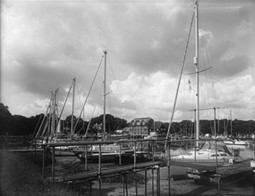Edward Mudge by Robin Caddy
With thanks to Robin Caddy for this contribution.
Our collection of postcards by Edward Mudge is a firm favourite and informs our understanding of life in the area in the early to mid-20th Century. Southampton based photographer Robin Caddy wanted to find out more about Mudge and his way of taking photographs:
Edward Mudge (1881-1964) lived and worked in the Waterside area from 1904 onwards. His photographs will be familiar to many of you from family albums and the wonderful archive at the New Forest Heritage Centre. I was inspired by a friendship with Mudge’s family to find out more about him and his working practices. Naturally I started with John Pemberton’s excellent talk and article which can be found on the website.
I wanted to pay tribute to Mudge and those today with a connection to him. I chose to interview and photograph three people and to recreate their favourite of Mudge’s many thousands of photographs. I also incorporated a few of my own choices.
As anyone who knows the history of Edward Mudge could have predicted, Ashlett Creek featured heavily in the stories and the photographs. To visit the vicinity of his first darkroom and home with his granddaughter was a great privilege. I was delighted to help her make the photograph below. Like the majority of Mudge’s work the negative is made on a glass plate rather than film (or a memory card!) I have then developed and scanned this “dry plate” negative. This hybrid process enables me to use older ways of working which I felt connected me to Mudge but to share them digitally. The images also have a different feel to modern digital photographs without seeming cliched.
I was incredibly grateful to the New Forest Heritage Centre’s centre manager Dr Kath Walker. She took the time to talk me through the collection and show me a large number of original postcards. This really was quite a thrill as it helped me understand their importance as historical documents and a visual record of the area. It also inspired me to ultimately present the photographs as postcards which I sent to those who had collaborated with me on this project.
We are all familiar with the “then and now” style of publication, which juxtaposes older photographs with present day rephotography of the scene. The photographs made this way were titled after the Mudge “originals” which had inspired them. I would encourage everyone to try some photography in this way. Using Mudge’s archive or our own family archive we can learn more about our history. It is even possible to use online maps to “visit” some locations in advance and see exactly where might be a good starting point. I would however encourage you to go beyond simply rephotographing a scene and really think about your connection to that landscape or place and what makes it resonate with you. Sometimes you may need to visit a location several times to really connect with it, make sure to record that whole process and see how your photographers change between visits.
If you would like to see more details of the whole process and the making of these photographs a short documentary video is included here: https://youtu.be/PZivEwNnccg
You may also be interested in my project about Fawley Power Station: https://thepowerstation.myportfolio.com/


